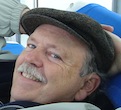Thom Riddle

Joined: 10 Jan 2006
Posts: 1597
Location: Buffalo, NY, USA (9G0)
|
 Posted: Sun Aug 06, 2006 8:38 am Post subject: Strange behavior Posted: Sun Aug 06, 2006 8:38 am Post subject: Strange behavior |
 |
|
During my BFR yesterday, the CFI put the Allegro into trimmed steady state flight at about 80 mph IAS. Then he banked to the left about 45 degrees and neutralized the ailerons and said "We are simulating a locked joystick condition, i.e., no elevator or aileron controls, only rudder and throttle. Get us safely out of this unusual attitude." I left the throttle alone and eased in right rudder and the Allegro resumed straight and level flight without too much adverse yaw or other anomalies.
Then the CFI did the same thing with a right bank. Now comes the interesting Allegro response. I eased in left rudder and it pitched slightly up with the yaw and then abruptly went very sharply nose down, not just a little bit but in steep dive angle. I caught it with the elevator and we both looked at each other with the obvious question marks on our faces that said "WTF__K was that?" We did it again from the right bank of about 45 degrees and this time I added the rudder more slowly still but at some point of yaw, the same abrupt and severe nose drop occurred which I caught again with the elevator. We tried it again from a left bank, and as before, nothing unseemly happened.
What follows is my analysis of what was happening. I am no aerodynamicist so this is just my best guess. In any case, whatever the cause, all Allegro pilots should be aware of this.
Rudder only, by its very nature, is an uncoordinated maneuver. When in a steep right bank and left rudder is added, the airplane begins to slip (high rudder, no aileron). Remember that we were flying fairly slowly around 80 mph IAS and the nose was pitched up and was also yawed left, thus allowing the higher (left) wing and fuselage to block flow to the horizontal stabilizer. Insufficient airflow over the elevator allowed the elevator to fall and the nose to pitch down. Note that it takes about 25-30 mph of airflow during straight flight or take-off run rather, to neutralize the weight of the elevator.
So why did it not do this on the opposite side? The only explanation I can think of is the prop creates a rotating airflow (clockwise from pilot's view) along and surrounding the fuselage. The airflow was blocked because of this rotational direction. On the other side (left bank recovery) the yaw direction was to the right and the rotating airflow was not blocked thus allowing maintenance of sufficient airflow over the horizontal stabilizer and elevator precluding the sudden nose down pitch response.
I'm considering trying a very light bungee on the joystick to hold it in neutral with zero airflow. This will change the trim settings a bit, but not in such a way that it is not predictable. Then I will repeat the maneuver at altitude and see what happens. Another way to test this theory without the bungee is to do it at higher airspeeds so the nose is not so pitched up and the airflow over the tail may not be diminished enough to cause the sudden loss of elevator power.
Fly safe!
| | - The Matronics Allegro-List Email Forum - | | | Use the List Feature Navigator to browse the many List utilities available such as the Email Subscriptions page, Archive Search & Download, 7-Day Browse, Chat, FAQ, Photoshare, and much more:
http://www.matronics.com/Navigator?Allegro-List |
|
_________________
Thom Riddle
Buffalo, NY (9G0)
Don't worry about old age... it doesn't last very long.
- Anonymous |
|


